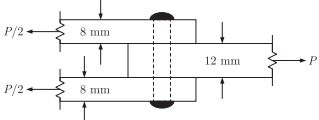Structural Engineering - Online Test
Q1. In the theory of plastic bending of beams, the ratio of plastic moment to yield
moment is called
Answer : Option A
Explaination / Solution:
No Explaination.
Q2. The square root of the ratio of moment of inertia of the cross-section to its cross-sectional
area is called
Answer : Option D
Explaination / Solution:
No Explaination.
Q3. A 12 mm thick plate is connected to two 8 mm thick plates, on either side through
a 16 mm diameter power driven field rivet as shown in the figure below. Assuming
permissible shear stress as 90 MPa and permissible bearing stress as 270 MPa in
the rivet, the rivet value of the joint is


Answer : Option B
Explaination / Solution:
No Explaination.
Q4. Consider the following statements for a compression member:
1. The elastic critical stress in compression increases with decrease in
slenderness ratio
2. The effective length depends on the boundary conditions at its ends.
3. The elastic critical stress in compression is independent of the slenderness
ratio.
4. The ratio of the effective length to its radius of gyration is called as
slenderness ratio
Which of the above statements is/are correct ?
Answer : Option D
Explaination / Solution:
No Explaination.
Q5. A precast concrete pile is driven with a 50 kN hammer railing through a height of
1.0 m with an efficiency of 0.6. The set value observed is 4 mm per below and the
combined temporary compression of the pile, cushion and the ground is 6 mm. As
per Modified Hiley Formula, the ultimate resistance of the pile is
Answer : Option B
Explaination / Solution:
No Explaination.
Q6. A plate load test is carried out on a 300 mm × 300 mm plate placed at 2 m below
the ground level to determine the bearing capacity of a 2 m × 2 m footing placed
at same depth of 2 m on a homogeneous sand deposit extending 10 m below
ground. The ground water table is 3 m below the ground level. Which of the
following factors does not require a correction to the bearing capacity determined
based on the load test ?
Answer : Option C
Explaination / Solution:
No Explaination.
Q7. Which of the flowing stress combinations are appropriate in identifying the critical
condition for the design of concrete pavements ?
Type of stress Location
a. Load 1. Corner
b. Temperature 2. Edge
3. Interior
Select the correct answer using the codes given below :
Answer : Option A
Explaination / Solution:
No Explaination.
Q8. The modulus of rupture of concrete in terms of its characteristic cube compressive
strength (fck) in MPa according to IS 456 : 2000 is
Answer : Option D
Explaination / Solution:
No Explaination.
Q9. For limit state of collapse, the partial safety factors recommended by IS 456
: 2000 for estimating the design strength of concrete and reinforcing steel are
respectively
Answer : Option C
Explaination / Solution:
No Explaination.
Q10. A rectangular concrete beam of width 120 mm and depth 200 mm is prestressed
by pre tensioning to a force of 150 kN at an eccentricity of 20 mm. The crosssectional
area of the prestressing steel is 87.5 mm2. Take modulus of elasticity of
steel and concrete as 2.1 × 105 MPa 3.0 × 104 MPa respectively. The percentage
loss of stress in the prestressing steel due to elastic deformation of concrete is
Answer : Option B
Explaination / Solution:
No Explaination.
